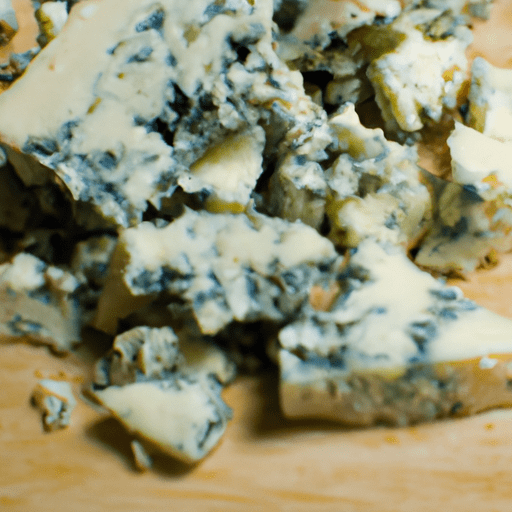Exploring the Rich and Tangy World of Bleu Cheese Crumbles
If you’re a cheese lover, chances are you’ve encountered the delightful and distinctive flavor of bleu cheese crumbles. Known for its striking blue veins and bold taste, these crumbles have been a staple in the culinary world for centuries. Whether used as a flavor enhancer, a key ingredient in recipes, or simply crumbled over a salad to add a touch of elegance, bleu cheese crumbles have a versatility that is truly unparalleled.
A Symphony of Flavors
Bleu cheese crumbles are a type of cheese made from cow’s, sheep’s, or goat’s milk that has been intentionally inoculated with mold spores, specifically Penicillium cultures. This unique fermentation process is what accounts for the distinctive blue veins and tangy flavor that bleu cheese is renowned for. The cheese itself has a crumbly texture that effortlessly melts in your mouth, revealing a complex taste that is simultaneously creamy, tangy, and slightly salty.
Unleashing Culinary Creativity
The versatility of bleu cheese crumbles in the kitchen knows no bounds. These crumbles can be incorporated into a wide range of dishes, adding a burst of flavor that elevates the entire meal. Here are just a few of the many ways you can enjoy bleu cheese crumbles:
1. Salad Toppings
Sprinkling bleu cheese crumbles over your favorite greens instantly transforms an average salad into a culinary masterpiece. Combine it with fresh fruits like pears or grapes, candied nuts, and a drizzle of balsamic glaze for a mouthwatering symphony of textures and flavors.
2. Pasta Perfection
Tossing some crumbled bleu cheese into pasta dishes like fettuccine Alfredo or creamy Gorgonzola sauce will result in a velvety and indulgent pasta experience. The crumbles add a depth of flavor that pairs exceptionally well with rich cream-based sauces.
3. Burger Bliss
Take your burger game to new heights by stuffing it with savory bleu cheese crumbles. As the patty cooks, the cheese melts into oozy goodness, creating a flavor explosion with every bite. Top it off with caramelized onions, arugula, and a swipe of mayo for the ultimate gourmet burger experience.
4. Mouthwatering Mashed Potatoes
Revamp your mashed potato recipe by folding in a generous amount of bleu cheese crumbles. The creamy and tangy notes of the cheese will complement the earthy flavor of the potatoes, making for a deliciously indulgent side dish.
Nutritional Benefits and Considerations
Beyond its delightful taste, bleu cheese crumbles also offer some nutritional benefits. They are a good source of protein, calcium, and vitamins, making them a healthy addition to your diet. However, it’s important to note that bleu cheese crumbles are also high in saturated fat and sodium, so moderation is key.
A Walk Through History
Bleu cheese can trace its origins back to ancient times. The process of inoculating cheese with mold spores was discovered by accident, with the unique flavor and appearance of the resulting cheese captivating the palates of many. Over the centuries, different varieties of bleu cheese - such as Roquefort, Gorgonzola, and Stilton - have emerged, each with its own distinct characteristics and production methods.
Intrigue on Your Plate
The world of bleu cheese crumbles is one that is filled with culinary intrigue. From its incredible taste to its wide range of uses in the kitchen, this cheese has certainly made its mark in the culinary world. So the next time you’re looking to add a burst of flavor to your dish, reach for some bleu cheese crumbles and prepare to embark on a delicious adventure.
Origin:
- Bleu cheese, also known as blue cheese, is believed to have originated in France around the 7th century.
- The specific origins of bleu cheese are often attributed to the regions of Roquefort, Gorgonzola, and Stilton.
Common Uses:
- Bleu cheese crumbles are commonly used as a topping or ingredient in salads, sandwiches, pasta dishes, and sauces.
- It is also used in various appetizers, such as cheese plates, stuffed mushrooms, and cheese balls.
Nutritional Benefits:
- Bleu cheese is a good source of protein, calcium, phosphorus, and vitamin B12.
- However, it is also high in fat and sodium, so it should be consumed in moderation.
Unique Properties:
- The blue veins in bleu cheese are created by the addition of specific mold spores, usually Penicillium roqueforti or Penicillium glaucum, during the cheese-making process.
- These mold spores develop and grow throughout the cheese, giving it its characteristic blue or greenish veins.
- The veins contribute to the unique flavor and aroma of bleu cheese, which can range from mild and creamy to strong and pungent.
Historical Significance:
- Bleu cheese has a long history and is considered one of the oldest types of cheese.
- It has been enjoyed across Europe for centuries and has become popular worldwide.
- Many traditional recipes and culinary traditions involve the use of bleu cheese, showcasing its cultural significance in various cuisines.




Use the share button below if you liked it.
It makes me smile, when I see it.